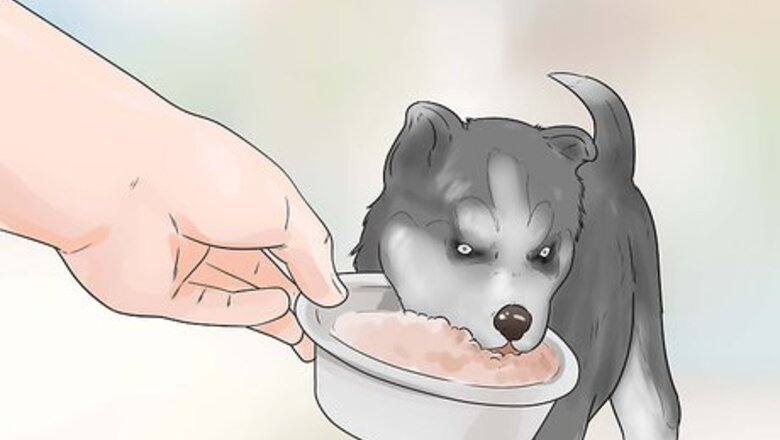
views
Caring for Your Puppy's Health
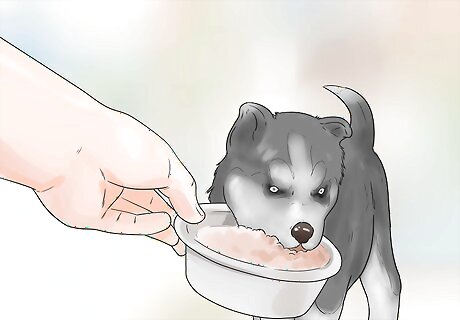
Feed three times daily, then wean to twice. An adult husky should eat two meals a day. Puppies, however, will need to eat more often to start. Feed your husky three meals a day until three months of age, then two meals a day after that. If the puppy is struggling to finish his meals or his tummy is very full and distended on three meals before the age of three months, then divide the daily allowance between four meals instead. At 12 to 16 weeks, you will notice the puppy just picks a little at the afternoon meal. At this point, you can discontinue it. Feed a high-quality food that is not full of artificial additives. This is important at any age, but especially so for a growing puppy. Feeding on a regular schedule will help with housebreaking the dog, as most husky puppies will need to go outside 15 to 30 minutes after eating. Do not allow your husky to "free feed" at any age. Providing meals at set times, and taking the dish away when the dog is done eating, is one way to show your stubborn husky that you are in charge.
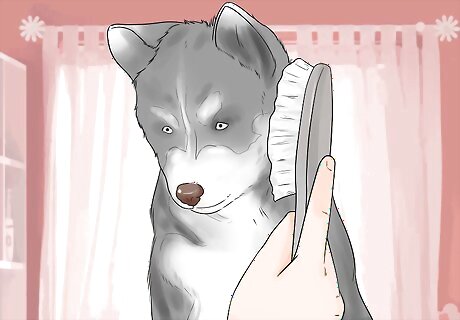
Brush your dog, don't bathe it. Huskies are naturally clean dogs. They will groom themselves, and have little odor. As a result, you can bathe a husky as seldom as once a year. But, the dog's thick coat will require frequent brushing. Most of the year, you should brush your dog once a week, taking this opportunity to clean and inspect its ears and brush his its teeth. During shedding season, daily brushing will help decrease shedding in your home.

Take care of your puppy's feet. Because huskies are working dogs, their feet are very important to them. You should trim long hairs on their feet and keep their nails trimmed. Dogs have blood vessels in their nails, so it's important not to trim too short. If you aren't experienced trimming a dog's nails, it may be best to ask a groomer or vet to do it, or at least show you how. If your dog isn't comfortable with you grooming its nails, you can train them to be calmer by playing with and touching their paws often.
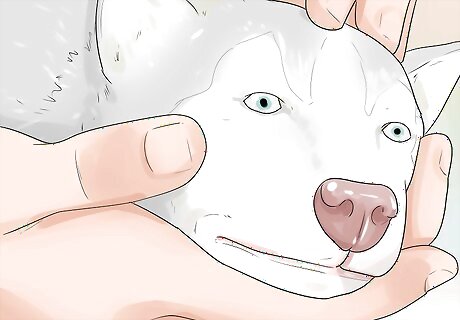
Get your puppy's eyes checked. Because the Siberian husky's tendency toward eye problems, it is important to get your puppy's eyes checked at a young age. Specifically, huskies are often diagnosed with: Cataracts, a film over the lens of the eye. Corneal dystrophy, cloudiness over the cornea that females are especially prone to. Progressive retinal atrophy, a condition in which the dog's eyes slowly degenerate until it becomes blind. These conditions are often hereditary. Find out all you can about your puppy's parents to find out if they are likely to occur.
Creating a Good Environment for Your Puppy

Prepare your home and yard to prevent escapes. Huskies are the escape artists of the dog world. You'll need to prepare your home for this, doing anything you can to make it hard for them to run away. A husky requires more or less constant vigilance. It will also require a fence that is at least 6 feet (1.8 m) high and difficult to dig under. Concrete or strong mesh at the base of the fence works well.
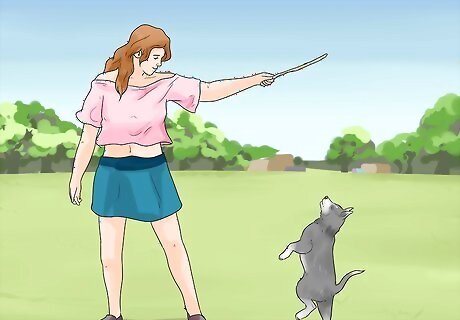
Give your puppy lots of exercise. Because of their active nature, Siberian husky puppies need a LOT of exercise. Huskies were bred as working dogs, so they are easily bored if they do not have a task. To keep your husky happy, you will need to make sure it gets 30 to 60 minutes of vigorous exercise every day. Huskies are great dogs to jog with once they get a little older. They love to run, play, and to chase things. Huskies are energetic and become bored easily. If you don't provide adequate exercise, the consequence will be an unhappy dog that howls constantly and tears apart your home.
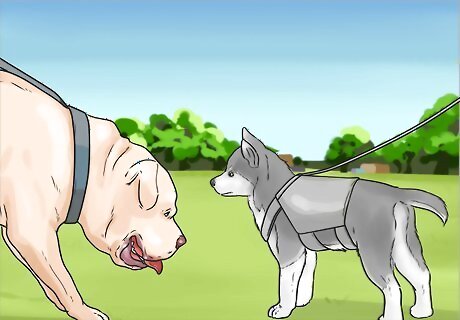
Introduce your puppy to other people and animals. Huskies are naturally friendly. But like any dog, a husky puppy will need socialization to develop a comfort with people and other animals. Make sure to take your puppy out into the world at a young age and introduce it to lots of people and other dogs. If your puppy seems nervous or suspicious of other dogs or people, puppy socialization and training classes can be a good idea. These classes help your dog learn the right way to interact with others. Socializing your dog at a young age will have a major impact on its personality later in life. Undesirable behaviors like biting, barking, and "resource guarding" are often a result of poor socialization. EXPERT TIP Sheri Williams Sheri Williams Certified Dog Trainer Sheri Williams is a Certified Dog Trainer and Behaviorist and the Owner of sheriwilliams.com, a business that specializes in teaching veterans how to turn their dogs into service dogs or emotional support animals to assist with PTSD. Based in the Los Angeles, California metro area, Sheri has over 20 years of dog training experience and also runs a general dog training practice specializing in rehabilitating dogs through positive reinforcement training techniques. She is certified by The Animal Behavior and Training Association. Sheri Williams Sheri Williams Certified Dog Trainer Socialize puppies properly while they're young. It's essential to properly socialize puppies when they're young, from birth up to around two years old. Set up positive interactions with mellow, friendly adult dogs to give the puppy good experiences. Doing this will teach them how to act with other dogs.
Training your Puppy
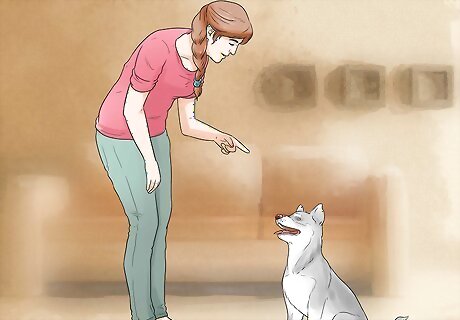
Set appropriate boundaries. Because huskies are so stubborn, it is important to set boundaries right away. They need to learn that you are in charge. Do not let your puppy sleep in your bed, as this creates confusion about its role in the family. You may make an occasional exception when the dog gets older. Have everyone in the household feed the dog a handful of kibble. This teaches your husky that everyone in the house can control its access to food. Be consistent with all rules you set. If you are not, the dog will learn that it can sometimes get what it wants if it tries hard enough. Make sure everyone else in the house on the same page. Be patient. Your dog can be trained if you are firm and consistent. Huskies often enjoy training tasks because they are work dogs.
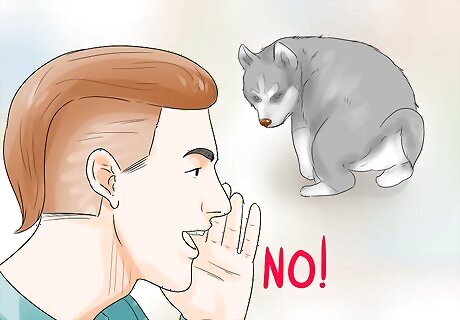
Potty train your puppy. Like any new puppy, your Siberian husky will have to be housebroken. There are three main components to potty training a dog: Monitoring your puppy. Keep a close eye on your puppy when it is inside to prevent accidents. This is easiest if you confine the dog to a small part of your home. If you catch your dog in the act of urinating or defecating inside, make a loud noise and say "no!" Then, promptly take the dog outside. Frequent trips outside. A puppy will need to go to the bathroom more often than an adult dog. To minimize the risk of indoor accidents, take the puppy out as often as you can, and on a regular schedule. Rewarding the desired behavior. When your dog goes to the bathroom outside, praise the dog and give it a reward in the form of a small treat. This will help it understand where it should do its business, and reinforce the behavior. Using a clicker can help your pup learn this faster (see below).

Crate train your puppy. An important part of potty training your dog is crate training. This is when you teach your puppy to be content spending time in its crate. Dogs will not want to soil their own space. For huskies, this is also a good way to minimize damage to your home when you can't be there. When you can't keep an eye on your puppy, put it in its crate with a treat or kibble and a chew toy. After a while, the dog will begin to enjoy spending time there, and may even retreat there if things get stressful. Crate training is easiest if you start by offering your dog a treat inside its crate without closing the door. After a day or so of doing this repeatedly, you can try closing the door for short periods of time. You can then build up to longer periods in the crate. Puppies under ten weeks old should not be confined to a crate for more than an hour. From weeks 11 to 14, your puppy can spend up to three hours in a crate. At weeks 15 and 16, up to four hours may be acceptable. After 17 weeks, a puppy can spend up to five hours in a crate. Never use going to the crate as punishment if you want to successfully crate train.
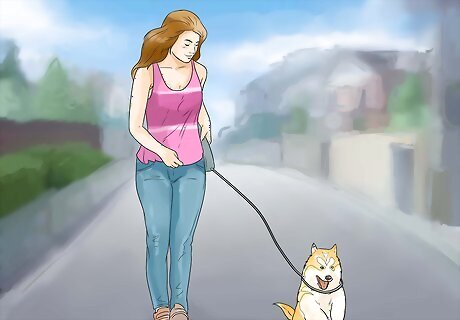
Leash train your puppy. Leash training is also crucial for huskies. Because of their tendency to run off, you must teach them to be cooperative walking on a leash. Huskies can easily run off and get lost if not on a leash. Get your dog used to the collar by putting one on it while it is eating. The dog will develop comfort and even a positive association with the collar. Then, start by just walking it around the house a little, giving it treats whenever it walks at your side and doesn't pull on the leash. Once you've got that down, try it outside! EXPERT TIP Colleen Demling-Riley, CPDT-KA, CBCC-KA, CDBC Colleen Demling-Riley, CPDT-KA, CBCC-KA, CDBC Canine Behavior Consultant Colleen Demling-Riley (CPDT-KA, CBCC-KA, CDBC) is a Canine Behavior Consultant and the Founder of Pawtopia Dog Training. With more than 20 years of experience, she specializes in creating and customizing dog management programs for dog owners. She is a Certified Pet Dog Trainer-Knowledge Assessed, Certified Behavior Consultant Canine-Knowledge Assessed, Certified Dog Behavior Consultant, and American Kennel Club Canine Good Citizen Evaluator. Colleen is a member of the International Association of Canine Professionals and has been a featured expert in national media including the New York Times, Woman’s Day, Readers Digest, Cosmopolitan, and Yahoo.com. Colleen Demling-Riley, CPDT-KA, CBCC-KA, CDBC Colleen Demling-Riley, CPDT-KA, CBCC-KA, CDBC Canine Behavior Consultant Huskies have high energy levels that set them apart from similar breeds like Malamutes. Huskies require plenty of exercise to release their energy. If they don't have outlets to release their energy, Huskies will often attempt escape by trying to open gates or digging under fences.
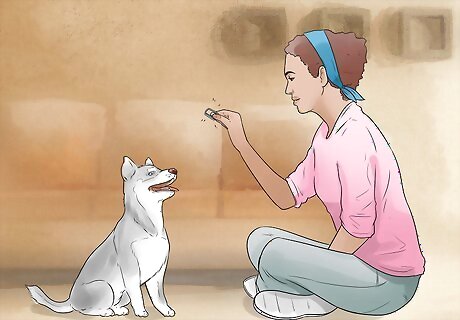
Train with a clicker. As with other puppies, clicker training is a good way to teach huskies commands and obedience. In clicker training, every time your dog does something desirable on command, you click the clicker and give it a treat. the combination of the sound and a reward helps your dog more quickly learn what you want it to do. Start by teaching your dog to associate the click with a treat. Just click at random intervals, then immediately provide a treat. Once your dog has learned this association, you can start using the clicker-treat combination to reward desired behaviors.
Preparing for the Future
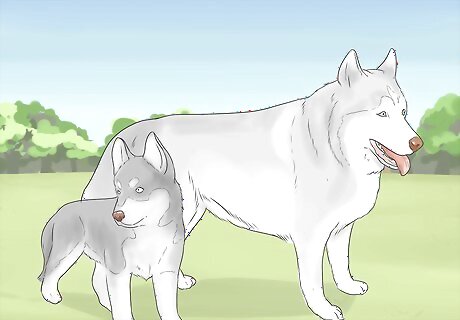
Learn the physical characteristics of huskies. As with any dog, it is valuable to know the important physical characteristics of the breed. Siberian huskies are sturdy dogs bred for physical labor in cold climates. Males, on average, will grow to a height of 21 to 23.5 inches (53.3 to 59.7 cm). They will weigh 45 to 60 pounds. Females will grow to an average of 20 to 22 inches (50.8 to 55.9 cm) and will weigh 35 to 50 pounds. Huskies don't suffer from a lot of health problems. However, there are some conditions you should be aware of. In addition to eye problems, they also may develop hip and elbow dysplasia. This is when these joints become malformed, resulting in pain and trouble walking. Huskies shed a lot, especially when the weather starts to get warm. Prepare to clean up a lot of dog hair. Barring accidents, you can expect your husky puppy to live an average of 12 to 15 years. You should be prepared to care for the dog for at least that long. Huskies do not do well in extremely hot or humid conditions. You should rule out a move to Arizona or Florida any time in the near future.
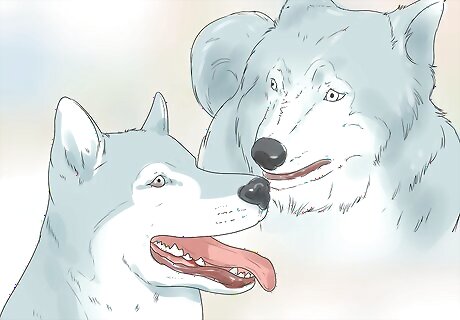
Understand the husky temperament. There are several personality and behavior characteristics that are helpful to know about as you train and socialize your new puppy. Huskies are extremely energetic and free spirited. They are active, high-energy dogs that get bored easily. This is why your husky may damage your home or yard and destroy your possessions if left alone for a long period of time. This also makes them ill-suited for life in small apartments. Huskies are strong-willed and intelligent. This can make them great companions, but can also make them more difficult to train than other dogs. Huskies are friendly and loyal. They are pack animals and do best with a family rather than a single owner. They are also friendly with strangers.

Prepare for howling. Huskies seldom bark, which is great news. The bad news is, they do tend to howl quite loudly. Proper training and exercise will minimize this behavior. But, especially early on, expect a lot of loud howling.














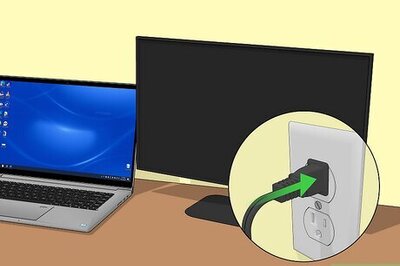
Comments
0 comment